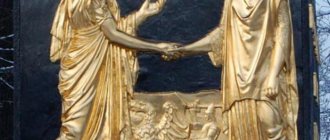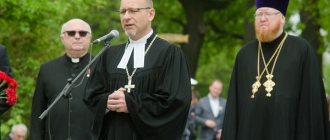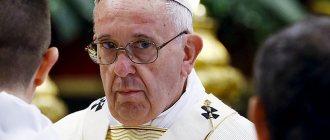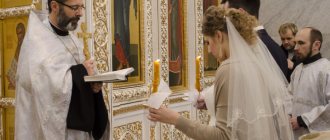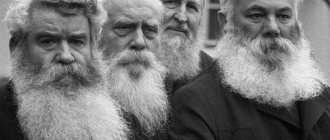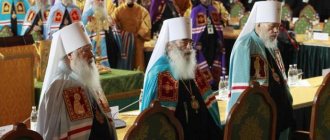Even in our time, the Ferraro-Florence Council of 1438-1445, at which the Union of Florence was adopted, causes fierce disputes both between historians and between Christians of the West and the East.
If for Catholics it, like the Ecumenical Council, is completely legal and the decisions are undeniable, then the Orthodox consider it a colossal mistake committed by the highest hierarchs of the Byzantine Church. The goal of the Empire, besieged by the Turks, to receive full-scale assistance from the West, was not achieved, and the desire of Catholics for the true unity of the Christian Church has since been subject to doubt in the East.
What is the Union of Florence
This is the name given in the works of historians to the agreement concluded in 1439 in Florence between the Eastern (Orthodox) and Western (Roman Catholic) Christian churches and declaring their formal unification.
The Orthodox confession recognized the primacy of Catholicism, led by the Roman Pontiff, the dogmas of purgatory and the procession of the Holy Spirit.
But she still retained the right to some of her own customs:
- Greek-language worship:
- possibility for priests, if they are not monks, to marry:
- communion of ordinary parishioners not only with the Body of Christ - in the form of bread, but also with His Blood - in the form of wine.
History of the Ferraro-Florence Cathedral
The XVII Ecumenical Council was convened by Pope Eugene IV as a counterweight and continuation of the Basel Council, which began in 1431. It was unusual in that it was attended by senior clergy from both denominations of Christianity. Its locations were Ferrara (1438-1439), Florence (1439-1442) and Rome (1442-1445).
Historical background
At that time, the weakened Christian world needed unification. Europe has still not recovered from the Crusades, the Byzantine Empire was almost completely captured by the Turks, and Rus' was subjected to Tatar raids.
For almost a century the Turks had occupied a foothold in Europe. Sultan Murad I turned Adrianople into his capital, and the troops of the Orthodox Serbs suffered a crushing defeat on Kosovo.
Under these conditions, the help of Western Christians was simply vital to Byzantium; the emperor understood that only an alliance with Rome could provide him with such help. Pope Eugene IV, who was also very interested in the unification of Christianity, made it a condition for the help of all Catholic Europe to conclude a union between the Eastern and Western churches. For this purpose, it was planned to convene a special Council, at which the best minds of Christianity could resolve the contradictions between the creeds of Constantinople and Rome.
Goals
Those gathered had a clear and precise goal, at first glance: the harmonization of dogmatic nuances between Orthodox and Catholics. Overcoming the contradictions in the Creed was the key to concluding an alliance - a union, with the help of which the Pope, on the one hand, could claim absolute leadership in Christian countries, and the Emperor of the “Second Rome” John VIII from the Palaiologan family, on the other, hoped to preserve the last provinces of his once a great state from the Ottoman conquest. As a result, by agreement of the parties, the Council was recognized as Ecumenical.
Participants of the Council
Many clergy who participated in the Basel Council that preceded it did not appear at the Council, which was the reason for their condemnation. The Pope, who led the Council, and the Byzantine Emperor, who approved it, were its inspirers.
More than seven hundred people came from the Orthodox Church, among them:
- Patriarch Joseph II;
- legates of all Orthodox patriarchs;
- two metropolitans - Isidore of Kiev and All Rus', who was elevated to bishop especially for this event;
- Metropolitan of Moldovala, a state that at that time occupied Moldova, part of Ukraine and Romania;
- bishop and representative of the royal house of Georgia.
Metropolitan Isidore, then bearing the title of Kyiv, arrived accompanied by the Suzdal bishop Abraham and many Russian priests.
Representatives of the Bulgarian and Serbian Orthodox churches did not attend the Council. Also, the monarchs of the West, whom the representatives of Byzantium had been waiting for, did not participate in it.
Unlike the Catholics, there were very few educated theologians in the huge Orthodox delegation. Among them are the legate of the Jerusalem Patriarch Mark of Ephesus and the representative of the Alexandrian throne, Vissarion of Nicea, as well as several scientists who did not bear the priesthood.
These were lay philosophers:
- Georgy Scholarius;
- Georgy Amirutts;
- George of Trebizond;
- elderly Georgy Gemist Plithon.
In the delegation of Rome, headed by Cardinal Cesarini, all members were to one degree or another theologically educated.
Its best minds were considered to be scientists who belonged to the Order of St. Dominica:
- Archbishop of Rhodes, Greek by birth, Andrew Chrysoberg;
- Archbishop of Lombardy John of Montenegro;
- Spanish Bishop John de Torquemada.
Pope Eugene IV himself was not inferior to them in knowledge of church dogma.
Holding a council
The Council of Ferrara-Florence officially began in Ferrara on April 1, 1438, with a solemn meeting under the leadership of the Pope, although working meetings had already been going on for more than two months.
Many questions were raised by the requirements of the protocol, which the Orthodox refused to comply with. For example, they did not kiss the papal shoe, as everyone else did in Catholic Europe. The Patriarch simply kissed the Pope on the cheek as a greeting.
It was also not possible to seat the participants of the Council immediately. The fact is that Catholics count the sides of the temple from the altar, and Orthodox - from the entrance. Therefore, the thrones of the Pope and the Holy Roman Emperor were placed on the right in accordance with the custom of Western Christians, and the Emperor of Byzantium and the Patriarch were placed on the right according to the custom of the East.
Back in the spring, immediately after the opening, the Council interrupted its work at the request of the Emperor of Byzantium, who wanted to wait for the arrival of European monarchs, and its meetings continued only in October. Canonical differences in religions were discussed.
In the winter of 1439 the cathedral moved to Florence. It was officially announced that the move was due to the fact that Italy was engulfed in a plague epidemic. But, according to the research of ancient and modern historians, this reason is not true: the epidemic had already ended by the time of the move. The Pope simply ran out of funds for the maintenance of the Council, and he could replenish his treasury only in Florence, which was loyal to him.
In the capital of Tuscany, the parties continued discussions about the procession of the Holy Spirit, and on June 4, a compromise formulation was signed based on the addition of “filioque” to the Creed, and after the death of the Patriarch of Constantinople on June 10, other central issues were quickly agreed upon - the priority of papal power, the existence of purgatory and etc.
Finally, on July 5, the hierarchs of the Eastern Church, including Isidore and Abraham from Russia, signed a document recognizing the union. The Moldovan Church also approved it. Only Mark of Ephesus officially refused to sign the document due to disagreement with its doctrine, and representatives of the Georgian, Abkhaz and other local churches, who also did not sign anything, simply left the Council without any statements.
In August, the Byzantine delegates also left Florence.
What issues were resolved
Since two Councils were taking place simultaneously, at first the participants in the Ferraro-Florence Council adopted decretals on its canonicity and condemned the cardinals and other priests who remained in Basel and even elected the antipope. Dogmatic disputes began in the summer of 1438 with a discussion about the procession of the Holy Spirit, that is, about the legality of adding the word “filioque” to the Christian Creed adopted at the Council of Nicaea-Constantinople. As a result, the addition of this word by the Western Church was approved and confirmed the procession of the Holy Spirit from both the Father and the Son.
Following this fundamental decision, the Council approved provisions on the right of the Pope to be the Supreme Pontiff of all Christians, as well as on the Eucharist and purgatory. As a result, Pope Eugene IV published the bull “Laetantur caeli”, which approved the unification of Christians of the Eastern and Western Churches. The text of the decision was signed by the Byzantine Emperor John VIII, 116 Catholic and 32 Orthodox delegates.
The document stated that the dogmatic contradictions between the currents of Christianity have been overcome, the concepts of the procession of the Holy Spirit “from the Father and the Son” and “from the Father through the Son” do not contradict each other. The Bishop of Rome, that is, the Pope, is the successor of St. Peter, and therefore has the highest authority in any Christian church. The existence of purgatory was emphasized, and the equivalence of the Eucharistic use of leavened bread and unleavened bread was recognized. Until now, for Catholics this bull has the status of an infallible canon.
Continuing its work after the departure of the Greek delegation, the Council:
- He canceled the decision of the Council of Constance on the subordination of the Pope to the Ecumenical Councils.
- Alliances were concluded with the Armenian and Coptic churches, and already in Rome - with the Maronite Church.
- The problems of the possibility of priests entering into marriage, as well as the acceptability of divorce, were raised, but they decided to postpone them to a later time.
The last meetings of the Council were held in Rome at the end of the summer of 1445.
UNION OF LYON
After K-pol was occupied by the troops of the Nicaean Empire (July 25, 1261), and Lat. imp. Baldwin II (1240-1273) and lat. Patriarch K-pol Pantaleone Giustiniani (1253-1286) fled from the city, Byzantium established itself in power. Palaiologan dynasty. Its founder was the Nicene emperor. Michael VIII Palaiologos was re-crowned as Emperor of the revived Byzantine Empire at St. Sophia (15 Aug. 1261). By this time the power of the Byzantines. the emperor was weakened by a number of internal and external factors, primarily the incessant attempts by the West. aristocracy to restore the Latin Empire.
Imp. Baldwin II, originally located on the island of Euboea, soon met with cor. Sicily by Manfred (1258-1266), and then visited Venice and Rome, where he found support for the Papal throne. Immediately after imp. Coronation of Michael VIII, Pope Urban IV (1261-1264) began preaching a new crusade, the goals of which were the reconquest of K-field and the restoration of Baldwin II to the throne, but most of the West. chivalry did not respond to this call. The only ruler interested in the expedition was Manfred, cor. Sicily. Back in 1257/58, he entered into an alliance with the despot of Epirus, Michael II Comnenus Ducas (c. 1230-1266/68), as well as with the ruler of the Achaean (Moray) principality, Guillaume II Villehardouin (1246-1278) against the Nicaean Empire; On June 2, 1259, Manfred married the daughter of Michael II.
In the Battle of Pelagonia (September 1259), the troops of the Principality of Morea and the Despotate of Epirus were defeated, Prince. Guillaume II is captured. Imp. Michael VIII promised him freedom in exchange for the return of Byzantium to the South. Peloponnese, and in 1261 the prince solemnly promised to hand over Mystras and Monemvasia to the emperor, and also became the successor of one of the sons of Michael VIII. The restoration of Byzantine control over these territories could become the basis for the gradual reconquest of the Byzantines. army of lands occupied by Latins, Bulgarians and Serbs. To prevent such a situation, Pope Urban IV, after some time, released Guillaume II from the oath given to the Byzantines. to the emperor.
A significant part of Italy was under the control of the Sicilian king, but the pontiff did not want to see Manfred at the head of the crusader army, since he was the illegitimate son of the emperor. Frederick II Staufen (1220-1250), led the Italian party. Ghibellines (supporters of the emperor in opposition to the Pope), and also entered into conflicts with Popes Innocent IV (1243-1254) and Alexander IV (1254-1261). Realizing the advantageous geographical position of Sicily as a springboard for Bud. expedition against Byzantium, the pope was looking for a ruler capable of overthrowing Manfred. As a result, the choice fell on Charles I of Anjou, brother of the French. cor. Louis IX Saint.
In 1262, Pope Urban IV began negotiations with the French. court, inviting Charles of Anjou to take the throne of the Kingdom of Sicily. According to the terms of the agreement concluded in June 1263, many were imposed on Charles. restrictions: he could not control appointments to church posts, could not claim imp. throne and occupy k.-l. post in the imperial part of Italy and in the Papal region, but in the fall he was elected senator of Rome, which was a violation of the treaty. After negotiations, both sides agreed to concessions. Elected to the Papal throne after the death of Urban IV, Pope Clement IV (1265-1268) continued the policies of his predecessor and on June 28, 1265 in Rome, proclaimed Charles King of Sicily.
Manfred, having gathered an army, marched against Charles of Anjou. After a small skirmish, Manfred was forced to retreat, as a result of which he lost power in the March of Ancona and his influence in Tuscany weakened. Charles of Anjou, through the mediation of the pope, collected the money that was necessary for the campaign against Manfred. In Oct. The army he recruited set out from Lyon and in January. 1266 arrived in Rome. 6 Jan Charles was crowned King of Sicily in Rome. basilica of st. Petra, 20 Jan. with his entire army he marched against Manfred. 26 Feb. in the battle of Benevento, Manfred’s army was defeated and he himself was killed. On March 7, Charles of Anjou solemnly entered Naples. However, only after the victory on August 23. 1268 at Tagliacozzo over Manfred's nephew Conradin, Hertz. Swabia and titular cor. Jerusalem (1254-1268), and his execution (Oct. 29, 1268), the new king of Sicily was able to begin implementing plans to create a large empire in the East. By this time, the island of Kerkyra (Corfu) and the eastern coast of the Ionian Sea - from Dyrrhachium (now Durres, Albania) to Butrint - were also under his control. May 24, 1267 Prince. Guillaume II Villehardouin gave Charles of Anjou the right to rule the Achaean principality after his death; On May 27, this decision was confirmed by Lat. imp. Baldwin II. After the death of Pope Clement IV (November 29, 1268), Charles of Anjou concluded treaties with the rulers of Hungary, Serbia and Bulgaria. However, the king's plans to expand his possessions were prevented by the promise to participate in the 8th Crusade, organized by Cor. Louis IX (see Art. Crusades).
In 1268, Emperor. Michael VIII Palaiologos, trying to prevent the aggressive plans of Charles of Anjou, sent an embassy, the purpose of which was to conclude an alliance with the Serbian cor. Stephen I Urosh (1243-1276). The union was planned to be sealed by the dynastic marriage of the Byzantine daughter. Emperor Anna and Tsarevich Milutin (later cor. Stefan Urosh II Milutin). After the unsuccessful embassy, Michael VIII began to consider negotiations with the Papal See on church union as the only way to prevent a war with Charles of Anjou. Since the negotiations were complicated by the fact that the Roman See remained vacant for a long time, Michael VIII sent an embassy to the French court. cor. Louis IX Saint. Byzantine. the embassy arrived in France in the summer of 1269. In a letter dated May 15, 1270, the College of Cardinals addressed Raoul de Groparmy, card.-bishop. Albano, responsible for preaching the 8th Crusade, was informed that the imp. Michael VIII declared the French. to the king about the desire of both himself and his subjects and clergy “to return to the obedience of the Roman Church and to unite in the profession of the same faith.” Louis IX replied that the resolution of this issue was within the competence of the College of Cardinals. The letter also mentioned attempts to restore the unity of the Church, undertaken under Popes Urban IV and Clement IV, and also spoke of a mandatory condition for achieving this unity - the confession of true Catholicism. faith (verae catholicae fidei professio). After the approval of the Catholic Confessions at the Council of the Polish Byzantine Church. the emperor, the Patriarch of Poland and other bishops, archimandrites, as well as representatives of the clergy and laity had to recognize the primacy of the Roman Church (Acta Urbani IV, Clementis IV, Gregorii X (1261-1276) / Ed. A. Tăutu. Vat., 1953. N 29. P. 78-84). Dr. The cardinals sent a letter to cor. Louis IX. Expressing hope for the speedy conclusion of a union, they warned the French. king from “Greek tricks” (Ibid. N 29a. P. 84-85).
Imp. Michael VIII sent the 2nd embassy to Louis IX, who was in Tunisia, headed by the court archdeacon. Konstantin Meliteniot and led. Chartophylax diac. John Vekkos (later Patriarch of Poland John XI Vekkos). Arriving at the site of ancient Carthage, the ambassadors found the French. the king already dying (Georg. Pachym. Hist. V 9).
Results and consequences
History has shown that the Council did not achieve the goals that its participants set for it.
Attitude of European states
Catholics in Western Europe received the news of the conclusion of the union rather indifferently. In any case, historical sources do not indicate any special celebrations that took place in honor of what seemed to be such an important event as the unification of Christians around the world.
Orthodox Christians in Europe, with the exception of Muscovite Rus', reacted more warmly to this event. Metropolitan Isidore, taking advantage of his high spiritual rank in the Orthodox Church and the fact that he was endowed with the rank of cardinal, returning from the Council through the lands of the Polish-Lithuanian Commonwealth in 1440-1441, took a number of actions to introduce a union in Poland and the Grand Duchy of Lithuania. Here, on the western borders of Rus', some Christians, including the nobility, still professed Orthodoxy and responded favorably to Isidore’s appeals. But the rulers of Poland and the Grand Duchy of Lithuania were in no hurry to provide state support for the union.
The reasons for such indifference, if not enmity, were, first of all, the confrontation between two popes: Eugene IV, on whose initiative the agreement was signed, and Felix V, elected by the Basel Council and supported by Poland.
So the Catholic Church itself had enough internal problems, and no one wanted to take on the problems of Eastern Christians - neither the hierarchs nor the secular authorities. In addition, a significant role in the delay in recognition of the union was played by the position of Prince Yuri Lugvenovich, who, having achieved independence from the Grand Duchy of Smolensk for a short period of time in 1440, counting on the support of Rome, introduced it on his lands. Therefore, the attitude towards this union and the decisions of the Council in general was ambiguous.
Russia's attitude
The conclusion of the Union of Florence in Rus' was perceived with hostility. Metropolitan Isidore, trying to prove that it was not in vain that he was one of the luminaries of the Ferrara-Florence Cathedral, began to enforce its decisions at such a pace and on such a scale that he amazed even Prince Vasily and his boyars who had seen everything.
Considering that the Metropolitan put Bishop Jonah of Ryazan in prison in order to force him to sign the Uniate Acts, and a simple Russian monk, who was in the Metropolitan’s retinue, in his report calls the Catholics “heretics” and not “brothers in Christ,” while declaring the Byzantines hierarchs are apostates and bribe-takers, it is easy to imagine the public opinion of Orthodox Rus'.
Upon returning from the Council, Isidore began to “break” Orthodox customs.
Eg:
- the eight-pointed cross familiar to Eastern Christians was replaced with a four-pointed one;
- The prayers indicated that the Pope should be remembered before the Patriarch.
Within a week, Grand Duke Vasily II the Dark and his entourage decided to stop such desecration of Orthodoxy, removed Metropolitan Isidore from office and sent him to the Chudov Monastery.
Having escaped from prison, after numerous adventures typical of a knight errant rather than a Christian bishop, Isidore gradually achieved the highest positions in both churches, but Moscow no longer recognized his rule.
At the end of 1448, the Council of Russian Clergy, against the will of Constantinople, elected Bishop Jonah as the spiritual ruler of all Rus'. This was the first primate elected from among the Russian, and not the Greek, clergy, and one could have expected an appropriate reaction, even anathema, but Constantinople, whose hands were tied, chose to remain silent. Thus, the Moscow Church acquired autocephaly, and, although the attitude towards the union in Constantinople often changed, this no longer affected anything. With the destruction of the Byzantine Empire, the “cradle of Orthodoxy,” Moscow actually acquired the status of the “Third Rome”; over time, the head of the Russian church began to be called the Patriarch, and the Moscow princes - tsars.
Refusal of the union
Almost all the Byzantine bishops who returned home also disavowed their signatures on the documents of the Council on the grounds that they were forced to do so under duress. The most powerful blow to the union was dealt by the position of the very influential priest Mark of Ephesus - the only one who loudly spoke out against it at the Council. He united the Orthodox around himself.
In 1443 in Jerusalem, and in 1450 in Constantinople, councils were held with the participation of the Eastern patriarchs, at which the Uniates were excommunicated. At the Council of Constantinople, Patriarch Gregory Mamma, a supporter of the union, was forced to give way to the orthodox Orthodox Athanasius.
However, the official church, together with the emperor of Byzantium in 1452, reaffirmed its commitment to the Florentine agreements, and on December 2 of the same year, the first service according to their canons was held in the Hagia Sophia. There were only a few months left before the fall of Constantinople.
It is worth noting that Pope Eugene IV did not break his vows and sent an army of crusaders against the Turks. True, in 1448, in the battle of Nicaea, the Christians were defeated, and 5 years later the Turks took the capital of Byzantium.
The significance of the council's decisions in history
The Union between the Catholic and Orthodox Churches of 1439, an attempt to unite the Christian churches of the East and West, was a complete failure, dividing Christians even more deeply into Orthodox and Catholics. However, in one local area - on the territory of Ukraine and Belarus, then belonging to the Grand Duchy of Lithuania - this agreement determined the development of the Christian church for many years.
For Russia, the main consequence of the union is the acquisition of autocephaly. Guided by the fact that “Tsargrad”, that is, Constantinople, followed the lead of the “Latins”, “schismatics”, “heretics”, Moscow decided to reject the spiritual support of Byzantium, especially since this state soon ceased to exist, and the throne of its Patriarch lost influence. As a result, the Moscow Metropolitan was installed without the blessing of Constantinople, and the Orthodox Church of Rus' was divided into two metropolitanates with centers in Moscow and Kyiv.
If Kyiv remained faithful to the “cradle of Orthodoxy,” even though it was under the heel of the Turks, then Moscow began to publish the works of its theologians year after year, castigating the “Greek defectors” and glorifying the steadfastness and inflexibility in the faith of the Moscow princes.
In the case of the Kyiv Metropolis, everything was more complicated. Until the beginning of the 16th century, the Roman pontiffs took a direct part in its affairs, appointing metropolitans in accordance with the Florentine agreements. In conditions when the Uniate Patriarch of Constantinople lived in Rome, the status of the Kyiv diocese was in limbo.
For several decades, the metropolitans did not recognize the fact that the documents on the basis of which the reconciliation of churches was achieved were no longer valid either in the eyes of Rome or in the eyes of Constantinople, which became Istanbul. And only more than half a century after the Council, which became the beginning of the union, they became convinced that the highest Catholic hierarchs of Poland and the Grand Duchy of Lithuania considered it to have lost all meaning.
Only a century and a half later, the Union of Brest of 1596 revived the spirit and principles of its predecessor, but at a local rather than a church-wide level.
Literature
- Church Union // Encyclopedic Dictionary of Brockhaus and Efron: in 86 volumes (82 volumes and 4 additional). - St. Petersburg, 1890-1907.
- Volkonsky A. M.
Catholicism and the Sacred Tradition of the East. — Paris, 1933. - Moskalik Ya. Concept of the Church of Metropolitan Andrei Sheptytsky. Lviv, 1997
- Senyk S. The Ukrainian Church and Latinization // Orientalia Christiana Periodica. 1990. Vol. 56. P. 165—187
- Senyk Sofia. Union of Brest: summing up // 400 years of the Brest Church Union (1596-1996): Critical reassessment. M., 1998. pp. 13-28.


